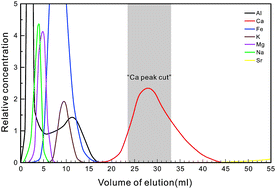A “peak cut” procedure of column separation for calcium isotope measurement using the double spike technique and thermal ionization mass spectrometry (TIMS)
Abstract
Full recovery from column separation and matrix effects are the two factors that need to be considered for the high-precision analysis of stable Ca isotopes, but generally they are difficult to balance. In many cases, to get a pure Ca fraction, the interference of the matrix elements is reduced at the cost of discarding a fraction of Ca overlapping with other elements (e.g. Sr and K). However, quantitative evaluation using this approach is challenging but greatly needed. Our study investigates the influence of low Ca recovery on δ44/40Ca using thermal ionization mass spectrometry (TIMS) with the double spike technique. δ44/40Ca of IAPSO seawater, ML3B-G and BHVO-2 in different Ca subcuts (e.g. 0–20, 20–40, 40–60, 60–80 and 80–100%), display limited variation after iterative correction by 42Ca–43Ca double spike with the exponential law. Notably, δ44/40Ca of each Ca subcut with ∼20% recovery is consistent with that of the Ca cut with full recovery, within a margin of error. Our results indicate that 42Ca–43Ca double spike technique can simultaneously correct Ca isotopic fractionation, occurring during column separation, and TIMS determination, because both follow the exponential fractionation law well. Therefore, a “peak cut” procedure of column separation for Ca isotope measurement using the double spike technique on TIMS is proposed. Briefly, we can mix the double spike with the sample solution well before column separation, then collect the peak of the Ca cut and abandon both sides of the Ca eluate that may overlap with other elements. This procedure would eliminate matrix effects efficiently, especially for samples with low CaO contents which typically must be passed through the column twice (e.g. peridotite and dunite).



 Please wait while we load your content...
Please wait while we load your content...